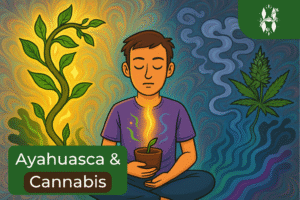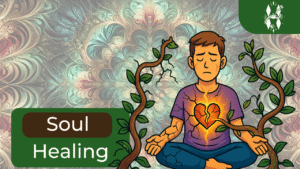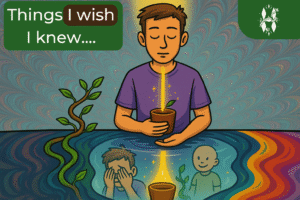In recent years and with the growing interest in the use of alternative therapies to help people in their healing processes, the so-called ancestral medicines (ayahuasca, hapey, kambó, among others) have become more apparent, although they have always been present in indigenous communities.
Only until this historical moment have they gained widespread popularity, and it is becoming easier to access them.
This opening to new forms of treatment brings a light of hope to many people who have not found in conventional medicine the answers to their problems.
However, it also requires a responsible approach and usage. There is also ignorance, prejudice, and misinterpretations about the use and possible associated effects.
An example of this are the isolated facts recorded by the media, where situations of inappropriate behavior following the intake of Ayahuasca could be understood by some people, who do not know the subject, as psychotic crises.
Key takeaways:
- Psychosis is a set of symptoms that include hallucinations, delusions, disorganized language, thought and behavior, and disconnection with reality.
Ayahuasca can produce transitory changes at the psychological level such as changes in the perception of time and space, visual and auditory changes along with religious-type experiences such as connection with mythical entities or gods.
- After the expected effects of an ayahuasca ceremony wear off, there is no scientific evidence that associates the appearance of psychotic symptoms after. However, some people with pre-existing medical conditions (schizophrenia) are at greater risk of experiencing them.
Table of Contents
What is a psychosis?
Let’s start by understanding what psychosis is. It is defined according to the Diagnostic and Statistical Manual of Mental Disorders of Psychiatry as:
- Transient or persistent appearance of delusional ideas (firmly held false beliefs, confused and without introspection).
- Hallucinations (sensory perceptions that are not perceived by anyone else).
- Disorganized thought and speech (speech that is rambling and not directed at any particular object, that shifts from one topic to another, and that can range from mildly disorganized to incoherent and incomprehensible).
- Frankly disorganized or catatonic behaviors (infantile behavior, agitation, inappropriate appearance, hygiene or conduct, holding a rigid posture and resisting movement, or making movements that have no purpose) that indicate loss of contact with reality. [1]

This article is written by Dr. Kevin David Zapata Castañeda
For Western medicine, psychosis is not a medical diagnosis but a group of symptoms that, together with other characteristics and in a time frame, can configure a schizophrenia-type mental illness and other related disorders.
Therefore, when talking about psychosis, it must be framed within a clinical context, considering the symptoms presented by the person, the duration of these symptoms, personal history of physical and mental illness, family history, and history of consumption of other substances.
When can we talk about substance-induced psychosis?
Considering the above, in order to speak of substance-induced psychosis, hallucinations and delusions must be greater than those that normally accompany simple intoxication or substance withdrawal; symptoms are usually brief and disappear shortly after the drug wears off; previous mental history must also be considered before considering that the acute psychotic episode is exclusively associated with the substance. [2]
What is Ayahuasca? The chemical compounds explained
Ayahuasca, also known by the names caapi, daime, yagé, and natema, is a drink composed of the association of two main plants: the infusion of the stems of Banisteriopsis caapi and the leaves of Psychotria viridis.
This association forms a synergistic compound containing β-carbolines (Harmaline, Harmine, and Tetrahydroharmine), which are reversible inhibitors of monoamine oxidase (MAO), and P. viridis, which contains N,N-dimethyltryptamine (DMT).
DMT is known to be a potent hallucinogen and is also metabolized and degraded by MAO in the liver and intestine; thus, ingestion of the drink provides increased serotonin concentrations.
Orally ingested DMT alone is practically inactive, as it is degraded very rapidly in the intestine and liver by the effect of monoamine oxidase-A, or MAO-A3.
Therefore, the presence of B-carboline compounds provided by Banisteriopsis (harmine, harmaline, and tetrahydroharmine) is required, which inhibit the effect of the MAO enzyme, thus allowing DMT to reach the central nervous system (CNS). There, it binds to the serotonergic receptors, causing its psychedelic effects.
The psychedelic effect of Ayahuasca
It is known as psychedelic to the psychic state of a person who is under the effects of a hallucinogen; these substances cause the individual to have a perception of different aspects of the mind, altering the state of consciousness and bringing sensations similar to the dream and ecstasy of a mystical-religious type.
In the scientific area, these altered states of consciousness are used to expand one’s own knowledge and consequently of the world, explore the universal mysteries, stimulate the imagination, and reestablish a harmonious relationship with nature, as Albert Hofmann, Terence McKenna, Graham Hancock, and Rupert Sheldrake have done.
Physically, the intake of Ayahuasca is characterized by vomiting, nausea, and diarrhea, changes in the size of the pupils, and changes in body temperature.
At the psychological level, some users have described changes in the perception of time and space, visual and auditory changes (greater sensitivity), and religious experiences such as connections with mystical entities or gods. [5]
It is important to consider that these effects are transitory, and their duration varies according to the person. They can occur up to six hours after the ingestion of Ayahuasca and tend to disappear once the session is over.
Anticipated effects of Ayahuasca and it’s relation to psychosis
Therefore, the effects that occur in this context and that are given within the scope of a ritual session of Ayahuasca intake cannot be considered or associated with psychotic effects since they are expected effects and at no time produce disconnection from the reality of the person.
On the contrary, many studies show benefits at the psychological level for cases of anxiety, depression, the treatment of addictions, and other psychological disorders, as well as therapeutic potential in the regulation of mindfulness and emotions. [2-6-7]
No scientific studies show a correlation between Ayahuasca and psychosis
As far as Ayahuasca is concerned, the relationship of Ayahuasca with psychotic experiences is poorly understood. Experiments conducted in controlled settings with healthy volunteers in which a single dose or several doses of ayahuasca have been administered have determined the good safety profile of the substance.
The studies describe transient episodes of dysphoria, anxiety, and symptoms of the psychotic sphere, especially perceptive, with spontaneous resolution in the following hours (usually in less than six hours) and without the need for pharmacological intervention. [8-9]
Does Ayahuasca cause psychosis?
To date, there is no clear scientific evidence linking the consumption of Ayahuasca in controlled environments (scientific, religious or ritual) and the development of psychotic episodes.
Risk of psychosis after Ayahuasca if these conditions apply
In a systematic review of published cases related to the development of psychotic episode after Ayahuasca consumption, different risk factors associated with the development of these symptoms are described, which are:
- Daily consumption of cannabis [10]
- Substance abuse including DMT and methamphetamines, personal history of psychosis and bipolar disorder [11]
- A couple of cases were also described in which the subject had a first-degree family history of paranoid schizophrenia (mother, father, siblings) [12]
- Simultaneous consumption of alcohol and thc prior to the ingestion of Ayahuasca [13]
- And consumption of neuropsychiatric drugs (specifically antidepressants of the MAO inhibitor group).
The responsible use of Ayahuasca
For this reason, although studies to date have not found a strong association between the development of a psychotic episode and these factors, it is important to consider them individually, in addition to the recommendations for preparation prior to the ingestion of ayahuasca (diets, suspension of drugs and certain medicines, purpose of the ceremony).
Traditional recipes
It is also very important to attend safe places, supported by an indigenous community or lineage of ancestral tradition, to ensure that the drink is indeed ayahuasca and not a mixture of other plants used for the purpose of swindling or stealing.
In addition to not buying drinks on the web that are passed off as Ayahuasca, because within the spiritual knowledge taught by the elders of the jungle should be considered the energy that moves through the plant and that is modified even from the time of planting, harvesting, gathering and cooking, in addition to the prayers and chants that are made to the spirit of Ayahuasca.
So that at the moment of taking it, it arrives with the intention of a true healing and a journey of self-discovery, thus protecting oneself from unwanted effects as well as supporting the communities that foster the traditional knowledge.
Research on medical use of Ayahuasca
Research on the medical use of Ayahuasca indicates good results in the treatment of addictions, depression and anxiety. [14]
In the case of substance use disorders, Ayahuasca could facilitate the maintenance of abstinence from alcohol, barbiturates, sedatives, cocaine and amphetamines.
With proper use, Ayahuasca has not demonstrated a risk of abuse or dependence [15], which is attributed to the fact that it does not show activation in the brain reward circuits according to images obtained through single photon emission computed tomography. [16]
HPPD (Hallucinogen Persistent Perception Disorder)
Finally, I would like to add a comment on something called hallucinogen persistent perception disorder (HPPD), which is described as persistent visual disturbances (geometric hallucinations, false perception of movement in peripheral visual fields, color flashes, changes in color intensity) accompanied by anxiety and distress, and which has been described mainly in LSD users.
However, it is known that similar visual phenomena can occur in the general population that has not consumed any type of psychedelics [17]. It has several forms of presentation, one of which is quite benign, self-limited, does not generate alterations in the family, social, or occupational area of people, and does not require medical attention, while the other type tends to be severe, requiring pharmacological management and psychiatric accompaniment.
This issue is still being debated and studied, and more clinical studies are needed to clarify its etiology.
Conclusion: Can Ayahuasca cause a psychotic break?
To date, there is no clear scientific evidence linking the consumption of Ayahuasca in controlled environments (scientific, religious, or ritual) with the development of psychotic episodes.
The cases described in the literature have been isolated episodes and cannot be attributed to a direct cause-effect with the ingestion of the drink, considering that the subjects had previous predisposing factors. The symptoms that a person may manifest during an Ayahuasca session (visions “pintas,” repetitive thoughts that lead to deep understandings and insights, transitory states of strong emotions “fear, insecurity, anxiety”, nausea, vomiting, and/or diarrhea) are all expected and known effects that may occur during a session and should not be considered psychotic effects or episodes since they do not meet the established criteria.
In the event that symptoms associated with a psychotic episode occur, these usually appear after the session is over (up to a week later) and usually subside completely with the correct use of medication.
It is of vital importance then, before deciding to take Ayahuasca, to have a clear intention to correctly follow the recommendations of nutrition, physical preparation, and suspension of pharmacological substances and recreational drugs, as well as to do it accompanied by prepared people who have the support of a lineage of traditional indigenous doctors.
Citations
1. Morrison, J. (2015) DSM-5® Guía para el diagnóstico clínico. Editorial El Manual Moderno
2. Pires, A. P. S., Oliveira, C. D. R. D., & Yonamine, M. (2010). Ayahuasca: uma revisão dos aspectos farmacológicos e toxicológicos. Revista de Ciências Farmacêuticas Básica e Aplicada, 31(1)
3. López A. Los alucinógenos. CSIC; 2017. p. 85–87.
4. Pereiro C., Fernández J., Guía de adicciones para especialistas en formación. Valencia: SOCIDROGALCOHOL; 2018. p. 309.
5. Gonçalves, J.; Luís, Â.; Gallardo, E.; Duarte, A.P. Evaluation of the In vitro Wound-Healing Potential of Ayahuasca. Molecules 2022, 27, 5760
6. Gonçalves J, Luís Â, Gallardo E, Duarte AP. A Systematic Review on the Therapeutic Effects of Ayahuasca Plants (Basel). 2023 Jul 7;12(13):2573. doi: 10.3390/plants12132573. PMID: 37447135; PMCID: PMC10346174.
7. Domínguez-Clavé, E., Soler, J., Pascual, J.C. et al. Ayahuasca improves emotion dysregulation in a community sample and in individuals with borderline-like traits. Psychopharmacology 236, 573–580 (2019)}
8. dos Santos RG, Balthazar FM, Bouso JC, Hallak JE. The current state of research on ayahuasca: A systematic review of human studies assessing psychiatric symptoms, neuropsychological functioning, and neuroimaging. J Psychopharmacol. 2016;30(12):1230-47.
9. Riba J, Rodríguez-Fornells A, Urbano G, Morte A, Antonijoan R, Montero M, et al. Subjective effects and tolerability of the South American psychoactive beverage Ayahuasca in healthy volunteers Psychopharmacology. 2001;154(1):85-95.
10. Umut G, Küçükparlak I, Özgen G, Türkcan A. Esrar Kullanimi Sirasinda Baslayan ve N, N- Dimetiltriptamin (Dmt) Kullanimi ile Psikotik Özellikler Eklenen Duygudurum Bozuklugu: Bir Olgu Sunumu. Dusunen Adam: The Journal of Psychiatry and Neurological Sciences. 2011;24(3): 246-250.
11 Paterson NE, Darby WC, Sandhu PS. N-dimethyltryptamine-induced psychosis Clin Neuropharmacol. 2015;38(4):141-3.
12. Neyra-Ontaneda D. Psicosis inducida por ayahuasca: reporte de un caso Rev Neuropsiquiatr. 2017;80(4):265.
13. Barbic D, Fernandes J, Eberdt C, and Chakraborty A. N,N-Dimethyltryptamine: DMT-induced psychosis. Am J Emerg Med. 2020;38(9):1961.e1-1961.e2
14. dos Santos RG, Osório FL, Crippa JAS, and Hallak JEC. Antidepressive and anxiolytic effects of ayahuasca: a systematic literature review of animal and human studies. Braz J Psychiatry. 2016;38(1):65-72.
15. Morgenstern J, Langenbucher J, Labouvie E. The generalizability of the dependence syndrome across substances: an examination of some properties of the proposed DSM-IV dependence criteria. Addiction. 1994;89(9):1105-13.
16. Fábregas JM, González D, Fondevila S, Cutchet M, Fernández X, Barbosa PCR, et al. Assessment of addiction severity among ritual users of ayahuasca. Drug Alcohol Depend. 2010;111(3):257-61.
17. Johansen, P. Ø., & Krebs, T. S. (2015). Psychedelics not linked to mental health problems or suicidal behavior: A population study Journal of Psychopharmacology, 29(3), 270-279.
18. Lerner, A. G., Rudinski, D., Bor, O., & Goodman, C. (2014) Flashbacks and HPPD: A Clinical-Oriented Concise Review The Israel journal of psychiatry and related sciences, 51(4), 296-301.




